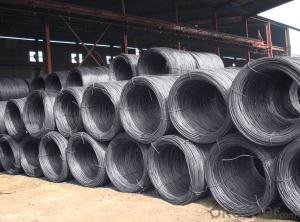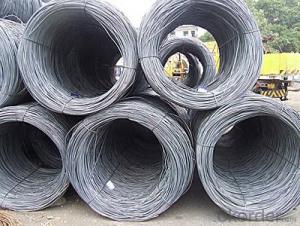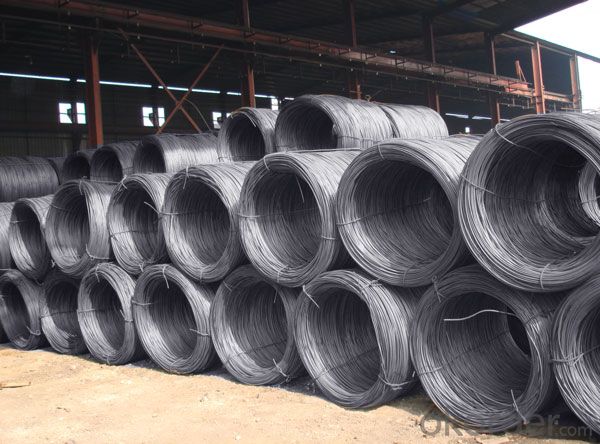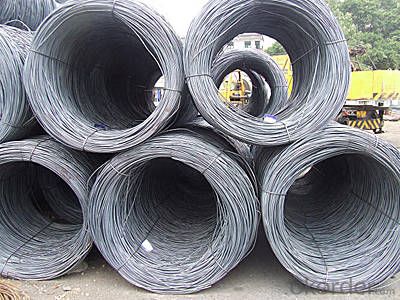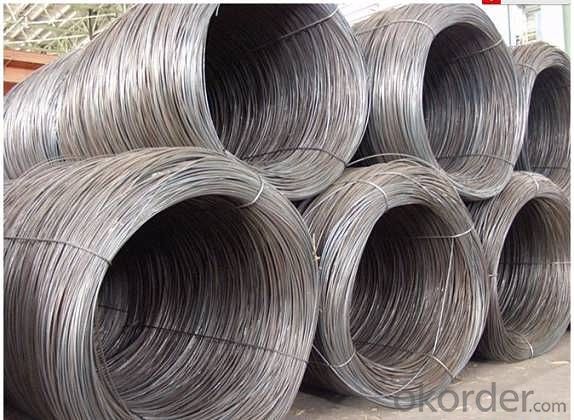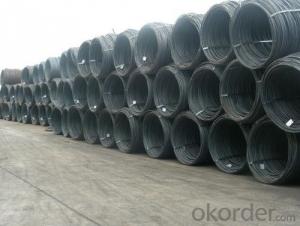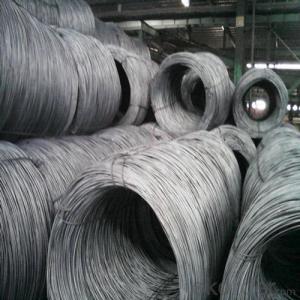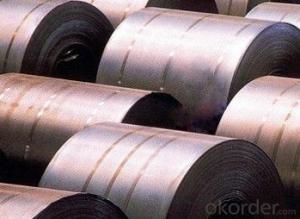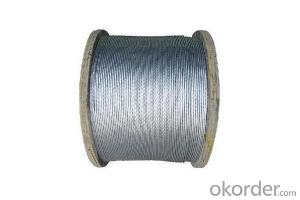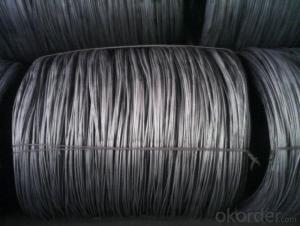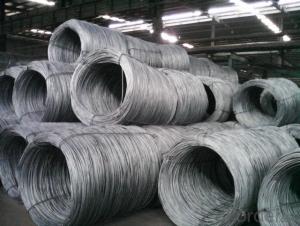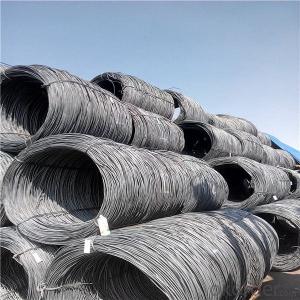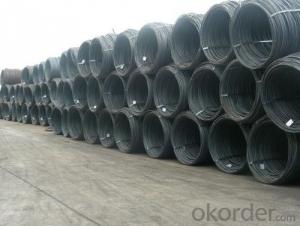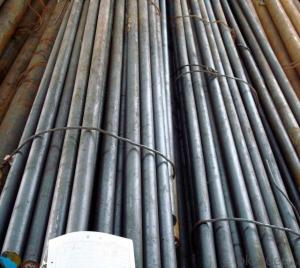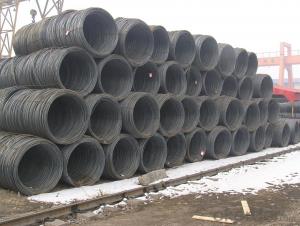Steel Wire Rod China Manufacturer Hot Rolled in Coils
- Loading Port:
- Tianjin
- Payment Terms:
- TT or LC
- Min Order Qty:
- 30 m.t.
- Supply Capability:
- 30000 m.t./month
OKorder Service Pledge
OKorder Financial Service
You Might Also Like
Product Description:
OKorder is offering Steel Wire Rod China Manufacturer Hot Rolled in Coils at great prices with worldwide shipping. Our supplier is a world-class manufacturer of steel, with our products utilized the world over. OKorder annually supplies products to European, North American and Asian markets. We provide quotations within 24 hours of receiving an inquiry and guarantee competitive prices.
Product Applications:
Steel Wire Rod China Manufacturer Hot Rolled in Coils are ideal for structural applications and are widely used in the construction of buildings and bridges, and the manufacturing, petrochemical, and transportation industries.
Product Advantages:
OKorder's Steel Wire Rod China Manufacturer Hot Rolled in Coils are durable, strong, and resist corrosion.
Main Product Features:
· Premium quality
· Prompt delivery & seaworthy packing (30 days after receiving deposit)
· Corrosion resistance
· Can be recycled and reused
· Mill test certification
· Professional Service
· Competitive pricing
Product Specifications:
1.Standard: AISI,ASTM,BS,DIN,GB,JIS
2.Wire Gauge: 5.5~14mm
3.Model Number: Q195, Q235, SAE1006, SAE1008
4.MOQ:25MT
Grade | Chemical Composition(%) | |||||
C | Mn | Si | S | P | B | |
SAE1006B | 0.03~O.07 | ≤0.32 | ≤0.30 | ≤0.045 | ≤0.040 | >0.0008 |
Mechanical properties | ||||||
Yield strength(N/mm2) | Tensile strength(N/mm2) | Elongation(%) | ||||
250-280 | 350-380 | ≥32 | ||||
Grade | Chemical Composition(%) | |||||
C | Mn | Si | S | P | B | |
SAE1008B | 0.10max | 0.3~O.50 | 0.15max | 0.050max | 0.040 max | 0.0008 min |
Mechanical properties | ||||||
Yield strength(N/mm2) | Tensile strength(N/mm2) | Elongation(%) | ||||
≥195 | 315-430 | ≥30 | ||||
Grade | Chemical Composition(%) | |||||
C | Mn | Si | S | P | B | |
Q195B | 0.06~O.12 | 0.25~O.50 | ≤0.30 | ≤0.050 | ≤0.045 | >0.0008 |
Mechanical properties | ||||||
Yield strength(N/mm2) | Tensile strength(N/mm2) | Elongation(%) | ||||
≥195 | 315-430 | ≥33 | ||||
Grade | Chemical Composition(%) | |||||
C | Mn | Si | S | P | B | |
Q235B | 0.12~O.2 | 0.3~O.701 | ≤0.30 | ≤0.045 | ≤0.045 | >0.0008 |
Mechanical properties | ||||||
Yield strength(N/mm2) | Tensile strength(N/mm2) | Elongation(%) | ||||
235 | 375-500 | ≥26 | ||||
FAQ:
Q1: Why buy Materials & Equipment from OKorder.com?
A1: All products offered byOKorder.com are carefully selected from China's most reliable manufacturing enterprises. Through its ISO certifications, OKorder.com adheres to the highest standards and a commitment to supply chain safety and customer satisfaction.
Q2: How do we guarantee the quality of our products?
A2: We have established an advanced quality management system which conducts strict quality tests at every step, from raw materials to the final product. At the same time, we provide extensive follow-up service assurances as required.
Q3: How soon can we receive the product after purchase?
A3: Within three days of placing an order, we will begin production. The specific shipping date is dependent upon international and government factors, but is typically 7 to 10 workdays.
Q4: What makes stainless steel stainless?
A4: Stainless steel must contain at least 10.5 % chromium. It is this element that reacts with the oxygen in the air to form a complex chrome-oxide surface layer that is invisible but strong enough to prevent further oxygen from "staining" (rusting) the surface. Higher levels of chromium and the addition of other alloying elements such as nickel and molybdenum enhance this surface layer and improve the corrosion resistance of the stainless material.
Q5: Can stainless steel rust?
A5: Stainless does not "rust" as you think of regular steel rusting with a red oxide on the surface that flakes off. If you see red rust it is probably due to some iron particles that have contaminated the surface of the stainless steel and it is these iron particles that are rusting. Look at the source of the rusting and see if you can remove it from the surface.
Images:
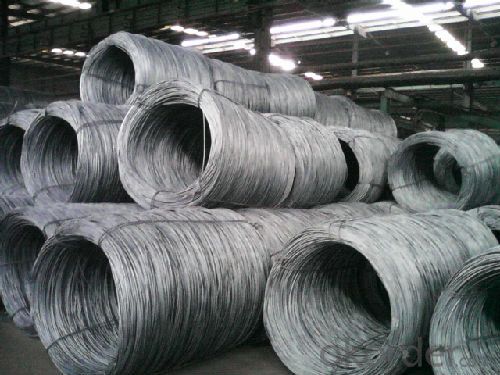
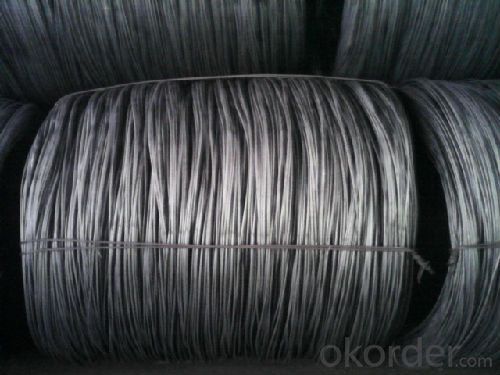
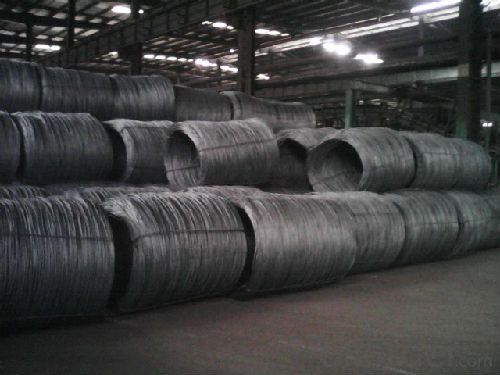

- Q: How is steel wire rod used in the manufacturing of tire reinforcement?
- Steel wire rod is used in the manufacturing of tire reinforcement primarily due to its high tensile strength. It is formed into fine wires and then woven or braided into a mesh, which is embedded within the tire's rubber layers. This reinforcement provides added strength and stability to the tire, allowing it to withstand the forces and pressures exerted during driving, ultimately enhancing its durability and safety.
- Q: What are the major trade associations and organizations in the steel wire rod industry?
- There are several major trade associations and organizations in the steel wire rod industry. Some of the prominent ones include: 1. American Wire Producers Association (AWPA): AWPA is a trade association representing manufacturers of steel wire and wire products in North America. It focuses on promoting the interests of the industry, providing technical expertise, and facilitating networking among its members. 2. International Wire & Machinery Association (IWMA): IWMA is a global trade association that brings together companies involved in the production and processing of wire and cable. It organizes industry events, offers market intelligence, and fosters collaboration and knowledge-sharing among its members. 3. Wire Association International (WAI): WAI is a nonprofit organization dedicated to promoting the advancement, education, and innovation in the wire and cable industry. It provides educational resources, organizes technical conferences and exhibitions, and offers networking opportunities for professionals in the field. 4. European Steel Association (EUROFER): EUROFER represents the European steel industry, including wire rod manufacturers. It aims to promote a competitive and sustainable steel industry in Europe, advocating for the interests of its members at the European Union level and providing industry-related information and services. 5. China Iron and Steel Association (CISA): CISA is a national trade association representing the Chinese iron and steel industry, including wire rod producers. It plays a crucial role in policy advocacy, market research, and coordination among the industry's stakeholders in China. These trade associations and organizations play a vital role in supporting the steel wire rod industry by providing a platform for collaboration, knowledge-sharing, and addressing common challenges. They also serve as valuable resources for industry professionals, offering technical expertise, market information, and networking opportunities.
- Q: How does the electrical conductivity of steel wire rod vary with different wire drawing processes?
- Different wire drawing processes can result in varying electrical conductivity for steel wire rods. Wire drawing involves pulling a wire rod through a series of dies to decrease its diameter and increase its length. This process can impact the electrical conductivity of the steel wire rod due to multiple factors. To begin with, reducing the diameter during wire drawing can lead to an increase in electrical conductivity. When the wire rod passes through the dies, its cross-sectional area decreases, resulting in a higher concentration of conductive material in a smaller space. This concentration of conductive material can enhance the electrical conductivity. Moreover, the wire drawing process can influence the microstructure of the steel wire rod, which subsequently affects its electrical conductivity. Deformation and strain during wire drawing can cause changes in the crystal structure and grain size of the steel. These changes significantly impact the electrical conductivity. For instance, grain refinement resulting from the wire drawing process enhances electrical conductivity by reducing electron scattering. Furthermore, the wire drawing process can introduce impurities or defects into the steel wire rod, which can disrupt its electrical conductivity. These impurities or defects act as scattering centers for electrons, thereby reducing the overall electrical conductivity. Additionally, the choice of lubricants and cooling methods during wire drawing can influence the electrical conductivity of the steel wire rod. Lubricants minimize friction and heat during the drawing process, preventing the formation of oxides or other surface contaminants that could hinder electrical conductivity. Effective cooling methods also maintain the desired microstructure and prevent the formation of detrimental phases that could impact electrical conductivity. In conclusion, the electrical conductivity of steel wire rods varies with different wire drawing processes. Factors such as diameter reduction, changes in microstructure, introduction of impurities or defects, and choice of lubricants and cooling methods all impact the electrical conductivity. Considering these factors carefully during the wire drawing process helps achieve the desired electrical conductivity for specific applications.
- Q: What are the factors that influence the cost of steel wire rod?
- The cost of steel wire rod is influenced by various factors. These factors include the prices of raw materials, particularly iron ore and scrap metal. Fluctuations in these prices can have a significant impact on the cost of production and, consequently, the price of steel wire rod. Additionally, the demand and supply dynamics for steel wire rod in industries such as construction, automotive, and manufacturing can affect its cost. When demand is high and supply is limited, the price tends to rise. Conversely, when demand is low and supply is abundant, the price may decrease. The cost of producing steel wire rod also includes expenses such as labor, energy, transportation, and equipment maintenance. Any changes in these costs, such as wage increases or fluctuations in energy prices, can affect the final price of steel wire rod. Moreover, currency exchange rates play a role in the cost of steel wire rod. Fluctuations in exchange rates can impact the cost of importing raw materials or exporting finished products. If the domestic currency strengthens against foreign currencies, the cost may increase, leading to higher prices. Government policies and regulations, such as tariffs, import/export restrictions, and environmental regulations, can also affect the cost of steel wire rod. These factors can impact the availability of raw materials, increase production costs, or create trade barriers, all of which can influence the final cost. Furthermore, market competition in the steel wire rod industry can impact its cost. Higher competition among manufacturers can result in price competition, leading to lower prices. Conversely, if there are fewer suppliers, they may have more pricing power, resulting in higher prices. It is important to note that these factors are interconnected and can change over time. Therefore, the cost of steel wire rod is subject to constant fluctuation, influenced by a combination of these factors and market dynamics.
- Q: How is steel wire rod used in the manufacturing of wire for geotechnical applications?
- Steel wire rod is widely used in the manufacturing of wire for geotechnical applications due to its exceptional strength, durability, and versatility. Geotechnical applications primarily involve soil stabilization, erosion control, and reinforcing structures in civil engineering projects. Firstly, steel wire rod is used to manufacture geogrids, which are high-strength woven or welded wire mesh structures. Geogrids are employed to reinforce soil and provide stabilization in various applications such as retaining walls, embankments, and slopes. The steel wire rod is formed into a mesh pattern and then coated with a protective material to enhance its resistance to corrosion and environmental factors. Additionally, steel wire rod is utilized in the production of steel strand cables, which are essential in geotechnical engineering for post-tensioning applications. These cables are used to reinforce concrete structures such as bridges, buildings, and foundations. The steel wire rod is twisted into strands and then bundled together to form a high-tensile strength cable. This cable is embedded in concrete and post-tensioned to provide additional support and prevent structural failure. Moreover, steel wire rod is employed in the manufacturing of gabions, which are wire mesh containers filled with stones or other materials. Gabions are widely used for erosion control, slope stabilization, and retaining walls. The steel wire rod is woven or welded to form a mesh cage-like structure, which is then filled with stones. The gabions provide a flexible and permeable structure that can absorb impact, prevent soil erosion, and stabilize slopes. In summary, steel wire rod plays a crucial role in the manufacturing of wire for geotechnical applications. Its strength, durability, and adaptability make it an ideal material for reinforcing soil, stabilizing slopes, and reinforcing structures. Whether in the form of geogrids, steel strand cables, or gabions, steel wire rod contributes significantly to the safety, stability, and longevity of various geotechnical engineering projects.
- Q: How is the impact resistance of steel wire rod tested?
- The impact resistance of steel wire rod is typically tested using a Charpy impact test. In this test, a notched specimen of the wire rod is subjected to a swinging pendulum that strikes and breaks the specimen. The energy absorbed by the specimen during fracture is measured, which provides an indication of its impact resistance.
- Q: What are the different heat treatment processes applied to steel wire rod?
- Some of the different heat treatment processes applied to steel wire rod include annealing, quenching and tempering, normalizing, and case hardening. Annealing involves heating the wire rod to a specific temperature and then slowly cooling it to improve its ductility and remove internal stresses. Quenching and tempering involves rapidly cooling the wire rod to increase its hardness and strength, followed by tempering to reduce brittleness. Normalizing is a similar process to annealing, but with a slightly different cooling rate to achieve desired mechanical properties. Case hardening involves adding a thin layer of a harder material to the surface of the wire rod to improve wear resistance.
- Q: What are the factors affecting the price of steel wire rod?
- There are several factors that can affect the price of steel wire rod, including the cost of raw materials such as iron ore and coal, supply and demand dynamics in the steel market, fluctuations in currency exchange rates, and government policies and regulations. Additionally, factors like production costs, transportation expenses, and the overall economic conditions can also have an impact on the price of steel wire rod.
- Q: How is steel wire rod used in the production of wire baskets for storage?
- Wire baskets for storage heavily rely on steel wire rod as a crucial component. The selection of the wire rod is primarily based on its strength, flexibility, and durability, which are essential qualities needed for producing sturdy and long-lasting wire baskets. Once the suitable steel wire rod is chosen, a series of manufacturing processes take place to convert it into the desired wire basket shape. Initially, the rod is fed through a machine that straightens and cuts it to the desired length. This procedure ensures uniformity and precision in the production of wire baskets. After the wire rod is straightened and cut, it is then shaped into the desired basket form using various techniques such as bending, welding, and forming. Bending machines are utilized to give the wire rod its basket-like structure, while welding processes are employed to securely join the wire rods together. Subsequently, the shaped and welded wire rod undergoes surface treatment processes like cleaning, coating, or galvanizing to enhance its appearance and provide protection against rust and corrosion. The surface treatment also contributes to improving the overall durability and longevity of the wire baskets. Finally, the wire baskets are assembled by attaching handles, lids, or dividers, depending on their intended use. This ensures that the wire baskets are functional and convenient for storage purposes. In conclusion, steel wire rod plays a crucial role in the production of wire baskets for storage. It provides the necessary strength, flexibility, and longevity required for producing durable and reliable wire baskets. Through a variety of manufacturing processes, the wire rod is shaped, welded, and treated to create functional and aesthetically pleasing wire baskets suitable for various storage needs.
- Q: How is steel wire rod used in the manufacturing of wire for surgical sutures?
- Steel wire rod is an essential component in the manufacturing process of wire for surgical sutures. The wire rod undergoes several steps to transform it into the high-quality wire used in sutures. Firstly, the steel wire rod is carefully selected to ensure it meets the required specifications for surgical sutures. The rod is typically made of stainless steel, which provides excellent strength, durability, and corrosion resistance. Once the appropriate steel wire rod is chosen, it undergoes a series of processes to shape and refine it. The rod is drawn through a series of dies that progressively reduce its diameter to the desired size for surgical sutures. This process is known as wire drawing and is crucial in achieving the precise diameter and smooth surface required for sutures. After the wire has been drawn to the correct diameter, it is thoroughly cleaned and inspected for any defects or impurities. This ensures that the wire is free from contaminants that could compromise its integrity and safety for medical use. The next step involves coating the wire with a biocompatible material to enhance its performance and reduce any potential adverse reactions within the human body. This coating can be made from various materials, such as silicone or polymers, depending on the specific requirements of the surgical sutures. Once the wire has been coated, it is wound onto spools or bobbins, ready to be further processed into sutures. The wire is carefully handled and packaged in a sterile environment to maintain its cleanliness and prevent any contamination. Finally, the wire is sent to the suture manufacturing facility, where it is cut into precise lengths and further processed to create the final surgical sutures. These sutures are then packaged and sterilized, ready to be used in various surgical procedures. In summary, steel wire rod plays a critical role in the manufacturing of wire for surgical sutures. Through a series of processes, the rod is transformed into high-quality wire with the necessary diameter, surface finish, and biocompatible coating. This wire is then used to produce sterile and reliable sutures that are vital in various medical procedures.
Send your message to us
Steel Wire Rod China Manufacturer Hot Rolled in Coils
- Loading Port:
- Tianjin
- Payment Terms:
- TT or LC
- Min Order Qty:
- 30 m.t.
- Supply Capability:
- 30000 m.t./month
OKorder Service Pledge
OKorder Financial Service
Similar products
Hot products
Hot Searches
Related keywords
